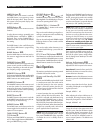
14
RX-1052 AM/FM Stereo Receiver
AC Input ]
Your RX-1052 is configured at the factory
for the proper AC line voltage in the country
where you purchased it (USA: 120 volts/60Hz
AC or CE: 230 volts /50 Hz AC ). The AC
line configuration is noted on a decal on the
back of your unit.
Plug the supplied cord into the AC INPUT re
-
ceptacle on the back of the unit.
NOTE: Memorized settings and labels are
preserved indefinitely, even if sthe RX-1052
is disconnected from AC power.
Master Power Switch \
The large rocker switch on the rear panel is
a master power switch. When it is in the OFF
position, power to the unit is completely off.
When it is in the ON position, the front panel
STANDBY and remote control ON/OFF but
-
tons can be used to activate the unit or put it
into standby mode.
NOTE: After all connections are completed,
the rear panel master power switch should
be put in the ON position and usually left in
that position.
12V TRIGGER Connections u
Many Rotel amplifiers offer the option of turning
them on and off using a 12 volt trigger signal
sent to them. These four connections provide
this 12 volt trigger signal from the RX-1052.
When the RX-1052 is activated, a 12 volt DC
signal is sent to the amplifiers to turn them on.
When the RX-1052 is put in STANDBY mode,
the trigger signal is interrupted and the am
-
plifiers turn off.
To use the remote turn on feature, connect one
of the RX-1052’s 12V TRIG OUT jacks to the
12 volt trigger input of a Rotel amplifier, us
-
ing a cable with mono 3.5 mm mini-plugs on
both ends. The +12 V DC signal appears at
the “tip” connector.
There are four 12V TRIG OUT connectors on
the back panel of the RX-1052, one for ZONE
2, one for ZONE 3, one for ZONE 4, and one
labeled ALL. The outputs for ZONES 2, 3, and
4 send a trigger signal ONLY when the corre
-
sponding zone is activated by the RX-1052.
The output labeled ALL sends a trigger signal
whenever the RX-1052 is activated for any
zone, including the main listening room.
IR IN Jacks i
Four 3.5 mm mini-jacks (labeled ZONE 2,
ZONE 3, ZONE 4, and EXT IN) receive com
-
mand codes from an industry-standard infra
-
red receivers (Xantech, etc.).
EXT IN: The EXT IN jack is used with an out
-
board IR receiver to duplicate the front panel
IR sensor. This feature is useful when the unit
is installed in a cabinet and the front panel
sensor is blocked or when IR signals need to
be relayed to other components.
ZONE 2 – 4: The ZONE 2 – 4 jacks are
used with IR repeater systems to receive sig
-
nals from IR control systems in remote zones
and control the RX-1052 only for the corre
-
sponding zone. For example, remote control
signals sent to the ZONE 2 input control only
the ZONE 2 features of the RX-1052. Signals
received at any of these inputs and can be re
-
layed to other components.
Consult your authorized Rotel dealer for in
-
formation on infrared repeater systems and
the proper wiring of a 3.5 mm mini-plugs to
fit the REM IN jacks.
NOTE: The IR signals from the IR IN jacks
can be relayed to source components using
external IR emitters or hard-wired connections
from the IR OUT jacks. See the following sec
-
tion for additional information.
IR OUT Jacks o
The IR OUT 1 & 2 jacks send IR signals received
at the IR IN jacks to an infrared blaster or emit
-
ter placed in front of a source component’s IR
sensor. In addition, the IR OUT jacks can be
hard-wired to Rotel CD players, DVD players,
or tuners with a compatible connector.
These outputs are used to allow IR signals
from Zone 2–4 to be sent to the source com
-
ponents, or to pass along IR signals from an
IR repeater in the main room when the sen
-
sors on the source components are blocked
by installation in a cabinet.
See your authorized Rotel dealer for informa
-
tion on IR emitters and repeater systems.
Computer I/O x
The RX-1052 can be operated from a computer
with audio system control software from third-
party developers. This control is accomplished
by sending operating codes from the computer
via a hard-wired RS-232 serial connection. In
addition, the RX-1052 can be updated using
special software from Rotel.
The COMPUTER I/O input provides the neces
-
sary network connections on the rear panel. It
accepts standard RJ-45 8-pin modular plugs,
such as those commonly used in 10-BaseT UTP
Ethernet cabling.
For additional information on the connections,
cabling, software, and operating codes for
computer control or updating of the RX-1052,
contact your authorized Rotel dealer or Rotel
Tech Support.
Making Connections
CD Player j
See Figure 6
Connect the left and right analog outputs from
the CD player to the AUDIO IN jacks labeled
CD (left and right).
There are no video connections for a CD
Player.
NOTE: With a Rotel CD player connected
to the CD inputs, the supplied remote control
can operate the basic transport and numeric
keypad functions of the CD player.
DVD Player l; z
See Figure 8
DVD connections can be made to the VIDEO
1, 2, 3, or 4 inputs.
Connect the left and right analog outputs from
the DVD player to the left and right audio IN
jacks of the desired VIDEO 1–4 input.
Connect a composite video cable from the out
-
put of the DVD player to the video IN jack.
NOTE:
When using a Rotel DVD player, con-
nect it to the VIDEO 4 inputs. This allows you
to use the supplied remote control to operate
the transport functions of the DVD player.


















